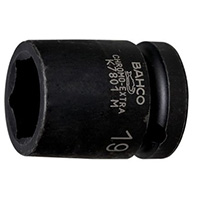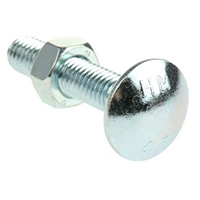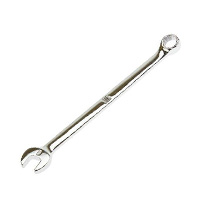
|
A Coach Screw is a heavy duty screw which has a square or hexagonal head and an externally threaded cylindrical shaft that tapers to a point at the tip. They are primarily used for holding together heavy timber, fixing metal to timber and in some cases masonry or concrete. They are also known as lag screws or lag bolts but should not be confused with coach bolts or carriage bolts. This handy chart below hi-lights a few differences between the two.
| Coach Screws vs Coach Bolts | ||
|---|---|---|
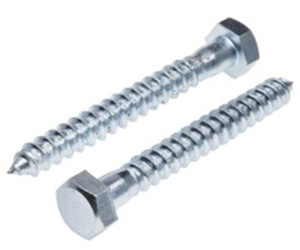 |
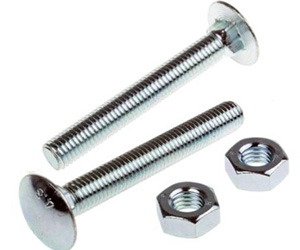 |
|
| Also known as | Lag Screws | Carriage Bolts |
| Available Thread sizes | 6mm, 8mm, 10mm, 12mm | M6, M8 and M10 |
| Available Thread lengths | 30mm - 120mm | 20mm - 110mm |
| Shaft | Tapered tip | Dowel shaped |
| Standards | DIN 571 | DIN 603, 555 |
| Fastening | These are tightened or loosened using a wrench spanner or impact socket on the coach screw head |
A spanner, wrench or impact socket is used to tighten or loosen the nut that is fed on to the end of the shaft |
| Application time | Time required to drill pilot hole and screw in coach screw |
Time required to drill hole, hammer through bolt and apply washer and nut |
How do I use a Coach Screw?
Timber: All coach screws require a pilot hole, using a general purpose drill bit such as a Twist Drill Bit, before they are screwed into place, preventing the wood from splitting. You will need to use a wood drill bit to drill the pilot hole. They are slightly different to metal drill bits as they have a point on the end to stop them slipping out of position. As a rule of thumb, the pilot hole diameter needs to be half the diameter of the coach screw when using softwood and three quarters when using hardwood. So for example when using an 8mm coach screw the pilot hole needs to be 4mm for softwood and 6mm for hardwood. Once the pilot hole has been drilled, the coach screw can be driven directly into the wood. When using coach screws on timber it is advisable to use a washer to avoid embedding the screw head into the wood on impact. This will also make it easier to remove the screw at any point. Another option is to use a flanged coach screw, this is a coach screw with an integrated washer built into the head.
Masonry: If you are using a coach screw to fix heavy objects to masonry or brickwork you will need to drill a hole, using an SDS Drill Bit. To ensure that any heavy object that will be fixed to the wall is secure, it is essential to use a wall plug with the coach screw. The wall plug will need to be the same size in diameter and depth as the hole you have drilled.
Important information
When tightening or loosening a coach screw it is important to use the correct size spanner, wrench or impacts socket to avoid damaging the head of the screw. The size you require can be determined by measuring across the flat edges of the head and not point to point.
TIMco have produced this great video ‘What’s the difference between coach screws and general purpose screws?’ where they also demonstrate how to use coach screws here
What are coach screws made of?
Most coach screws are made from steel and are offered in a number of different finishes:
Stainless Steel – offers good corrosion resistance making them ideal for outdoor use. They are also highly recommended for use with timber such as Oak and Cedar as these particular types of wood can contain acid and chemicals which can corrode metal. There are two main grades of Stainless Steel:
- A2(304) - can handle high and low temperatures
- A4(316) - can handle high and low temperatures but has a higher corrosion resistance making them ideal for coastal areas or areas with high pollution.
Bright Zinc Plated – provides moderate corrosion resistance and are suitable for indoor use in a dry environment.
Green Organic Coating – provides a weather resistant coating and are ideal for external use, making them ideal for projects such as decking.
Passivated – this is a two-part deep cleansing process to remove any free iron or other contaminants from the surface. This process helps maximise the corrosion resistance of stainless steel.
Hot Dipped Galvanised – has a thicker Zinc coating to Zinc Plated, giving them a better corrosion resistance, making them more suitable for outdoor use. The thicker coating produces a dull metal finish.
Choosing the correct size of coach screw
Coach screws come in an array of different sizes and are manufactured to confirm with DIN 571 German national standard dimensions
DIN571 Dimensions for coach screws
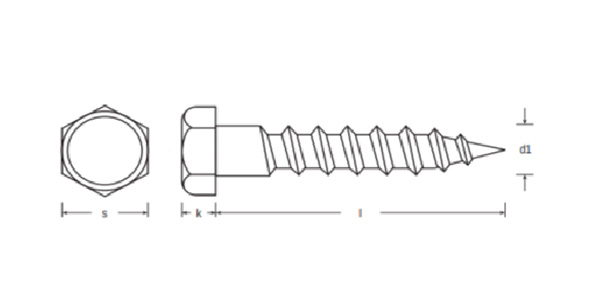
Diameter d | Diameter of shank d1 | Thickness of head k | Width across flats s | |||||
|---|---|---|---|---|---|---|---|---|
| max. | min. | max. | min. | max. | min. | |||
| M4 | 4.00 | 3.52 | 3.10 | 2.50 | 7.00 | 6.64 | ||
| M5 | 5.00 | 4.52 | 3.88 | 3.13 | 8.00 | 7.64 | ||
| M6 | 6.00 | 5.52 | 4.38 | 3.63 | 10.00 | 9.64 | ||
| M7 | 7.00 | 6.42 | 5.38 | 4.63 | 12.00 | 11.57 | ||
| M8 | 8.00 | 7.42 | 5.88 | 5.13 | 13.00 | 12.57 | ||
| M10 | 10.00 | 9.42 | 7.45 | 6.55 | 17.00 | 16.57 | ||
| M12 | 12.00 | 11.30 | 8.45 | 7.55 | 19.00 | 18.46 | ||
| M16 | 16.00 | 15.30 | 10.45 | 9.55 | 24.00 | 23.16 | ||
Diameter: This refers to the screws outer diameter of the threaded section of the shaft and is always listed first. So, a screw listed as M4 will fit a 4mm diameter hole.
Length: This refers to the length of the shaft from the tip to underneath the head.
Quick tips for coach screw applications
- To stop the coach screw from becoming stuck in wood, rub the threaded shaft with hand soap.
- Similarly, when using coach screws with masonry, dip the screw in oil before use.
- Watch this great YouTube video for hints and tips for drilling into masonry.
- If you are unsure of the diameter of the coach screw, hold a drill bit against the shaft. If the drill bit matches the diameter of the shaft, excluding the thread, then this will provide you with the screw diameter.
Product spotlights
Use one of these links to browse the product ranges:
